After the opening round of the group stage in the FIFA World Cup 2022, Group E looked like it had the potential to be the tightest group of them all. Walid Regragui’s Morocco held 2018 finalists Croatia to a 0-0 stalemate in quite a drab contest.
Morocco’s defensive work was admirable, combining zonal and man orientation to prevent penetration through Croatia’s midfield with Sofyan Amrabat’s excellent awareness. However, Croatia were very underwhelming themselves, with their chances largely coming from avoidable Moroccan errors in their own half.
On the other hand, Canada were exciting. Despite their aggressive first-half performance, the Maple Leafs failed to capitalise on their momentum and chances through poor final-third decision-making. One moment of quality from Belgium to exploit Canada’s slower centre-backs allowed Michy Batshuayi to score the matchwinner in a heart-breaking defeat for John Herdman’s side.
However, there were many promising signs in a Canadian performance that Croatia and Morocco certainly wouldn’t be looking forward to facing. And Herdman agrees, telling his players after the Belgium defeat that “they belong here, and we’re gonna go and ‘F’ Croatia”.
Following Morocco’s 2-0 triumph over a dismal Belgium side earlier in the day, Canada had the additional disturbance of knowing a loss against Croatia would end their hopes of reaching the knockout stages. After yet another aggressive start with Alphonso Davies scoring Canada’s first-ever World Cup goal, Croatia’s technical quality gained control and took the impetus away from the Maple Leafs. Sustaining pressure towards the end of the first half, Zlatko Dalić’s side found the breakthrough and then entered the lead just before half-time.
In this tactical analysis, we will look at the tactics that eventually allowed Croatia to pull Canada apart after another quick start from the North Americans.
Lineups
Zlatko Dalić selected ten of the eleven starters from their uninspiring bore draw with Morocco. The single Croatian change was the introduction of Hajduk Split striker Marko Livaja to replace Nikola Vlašić. Livaja is a league-leading attacker in the Croatian HNL, registering a combined 18 goals and assists from an xG+A of 14.65 as the focal point in Hajduk’s 4-2-3-1. His inclusion shifted Hoffenheim attacker Andrej Kramarić into a freer role towards the right wing. Kramarić is at his best when operating alongside a more traditional striker, and the former Leicester City man proved that against Canada.
Croatia continued with the masterful midfield trio consisting of Inter Milan pivot Marcelo Brozović, Chelsea line-breaker Mateo Kovačić, and Real Madrid maestro Luka Modrić. With a combined age of 95 and 322 Croatian caps between them, they are certainly not lacking international experience. After some initial struggles, the three-man midfield began to control the game, with substitute midfielder Lovro Majer also coming off the bench to find the back of the net.
VfB Stuttgart’s Borna Sosa and Celtic’s Josip Juranović remained to provide attacking influence from the defensive line. Former Liverpool centre-back Dejan Lovren stayed at the heart of Croatia’s defence, despite the feeling that Josip Šutalo’s ball-playing ability could’ve been game-changing against Morocco. He was partnered by 20-year-old Joško Gvardiol, arguably the most wanted left-footed centre-back in the world.
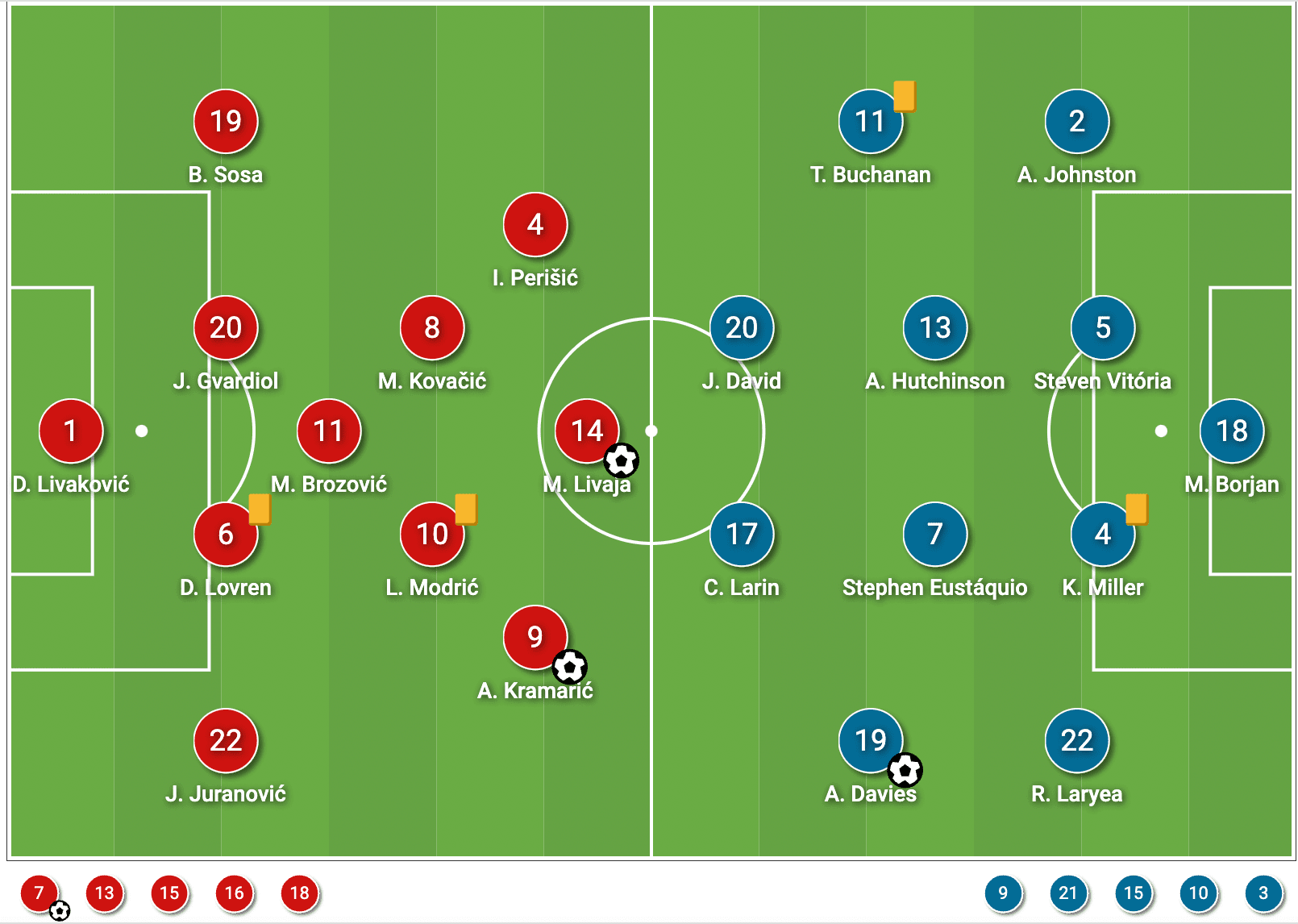
Despite producing such an energetic performance against Roberto Martínez’s Belgian Red Devils, John Herdman also decided to only make one change to the Canadian starting eleven. Reading’s Junior Hoilett was replaced by Cyle Larin, who likes to operate as more of a target man. Larin has been starved for minutes as a new signing at Belgian side Club Brugge, but he was trusted to start alongside Lille striker Jonathan David and Tajon Buchanan, his exciting teammate in Belgium.
39-year-old captain Atiba Hutchinson remained as the experienced midfield partner of FC Porto’s Stephen Eustáquio, who was superb against Belgium. Although they were underloaded in the midfield, Hutchinson and Eustáquio worked well out of possession to limit central progression from Belgium despite the occasionally open spaces. However, being underloaded once again facing Croatia’s midfield was too much for Canada.
The two wing-backs of Richie Laryea and Bayern Munich superstar Alphonso Davies also performed exceptionally well with their pressing and jumping to overcome Belgium’s switches of play. Additionally, the duo were central to penalty controversy, with Davies taking and missing the crucial first-half penalty ahead of more regular takers in Jonathan David and centre-back Steven Vitória. Laryea, on the other hand, was brought down by Axel Witsel inside the box without a penalty being awarded. However, against Croatia, the pair linked up on the left, with Davies appearing as the left midfielder ahead of Laryea at left-back.
Vitória, who has spent the majority of his senior career in Portugal and is currently a key starter for G.D Chaves, started in the centre of Canada’s defence with left-footed Kamal Miller. Miler’s all-around physical qualities are superior to his defensive partners and are required with Red Star Belgrade goalkeeper Milan Borjan not matching the sweeper-keeper profile. Miller’s teammate at CF Montréal in Alistair Johnston provided right-side overloads with Laryea and Buchanan to terrorise Belgium’s Yannick Carrasco, who was substituted at half-time. Johnston started strongly at right-back against Croatia, handling Tottenham Hotspur’s Ivan Perišić well 1vs1.
Canada’s pressing change
With Canada regularly rotating between a 3-4-3 and a 4-4-2 during CONCACAF World Cup qualifying, John Herdman has established familiarity and tactical versatility that has been tested to the maximum in Qatar. When facing Belgium, ranked second in the FIFA rankings, Canada bravely pressed high and matched up against Roberto Martínez’s 3-4-3. This meant Canada’s front three aggressively pressed the Belgian back three and forced play between the centre-backs and wing-backs, preventing access to the midfielders. Canada’s wing-backs would jump the pass to Belgium’s wing-backs and with the ball in wide areas, the Maple Leafs would go man-to-man on the ball side.
However, coming up against Croatia’s back four in their 4-3-3, Canada switched to their 4-4-2. The core principle of supplying pressure to the opposition full-back remained, with Canada’s wide midfielders being immediately triggered to press by Croatia’s centre-back passing to the full-back. Although, as the game continued, the full-back trigger was a strenuous task. The wide midfielders were then too slow to apply pressure with support from midfield shifting across also at a slower rate. This allowed Croatia’s full-backs and midfielders to receive without immediate pressure and time to turn and play.
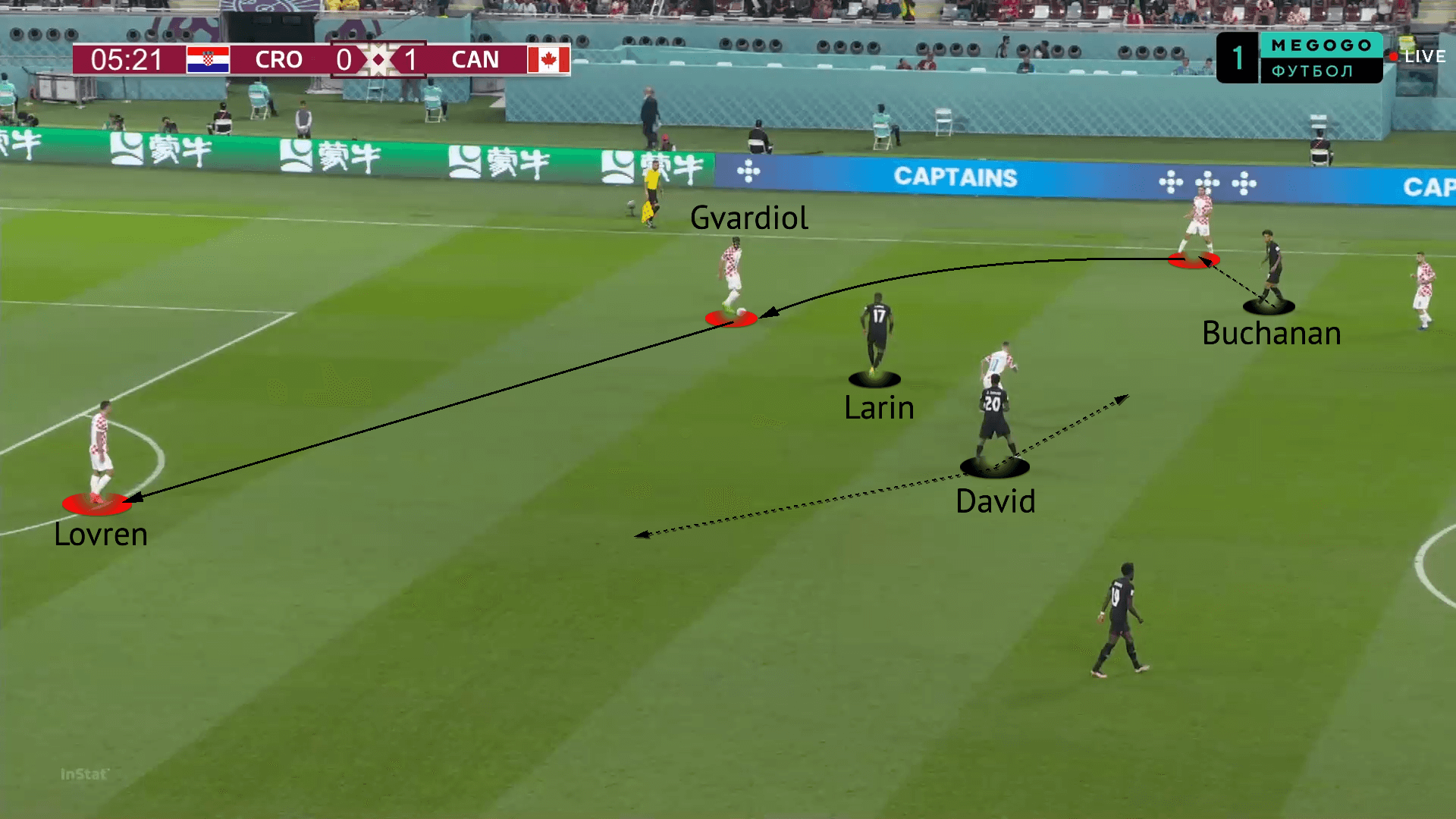
Compared to their off-ball performance against Belgium, Canada were much more passive when Croatia’s centre-backs had possession. Facing Croatia’s 2-1 build-up involving centre-backs Dejan Lovren and Joško Gvardiol with pivot player Marcelo Brozović, Canada alternated pressing the ball-holder with their front two.
In the example above, right midfielder Tajon Buchanan initially pressed Croatia left-back Borna Sosa upon reception, forcing play backwards to Gvardiol. Ball-side striker Cyle Larin would look to engage Gvardiol, not pressing with much intensity but he is aware of the potential passing lane into Brozović like Buchanan is with Mateo Kovačić over his left shoulder.
With Larin engaging Gvardiol, the far-side striker Jonathan David drops in to cover Brozović, whilst also being ready to jump the square pass to Lovren. In this scenario, Larin would drop onto Brozović as David engages Lovren. The figure below is an example of this, although in this specific example it is once again Larin engaging the press after the square ball with David then dropping onto Brozović.
Despite calls for Josip Šutalo’s introduction over Lovren, the experienced centre-back was able to cope with the slight pressure Canada exerted during the Croatian build-up. With Lovren surviving pressure, the technically superior Gvardiol and Brozović flourished to retain and progress possession, with Brozović in particular breaking lines effortlessly. Croatia’s technical quality was always going to exploit Canada’s decreased pressing intensity in the build-up phase, and their midfielders astutely combined to find space in the midfield.
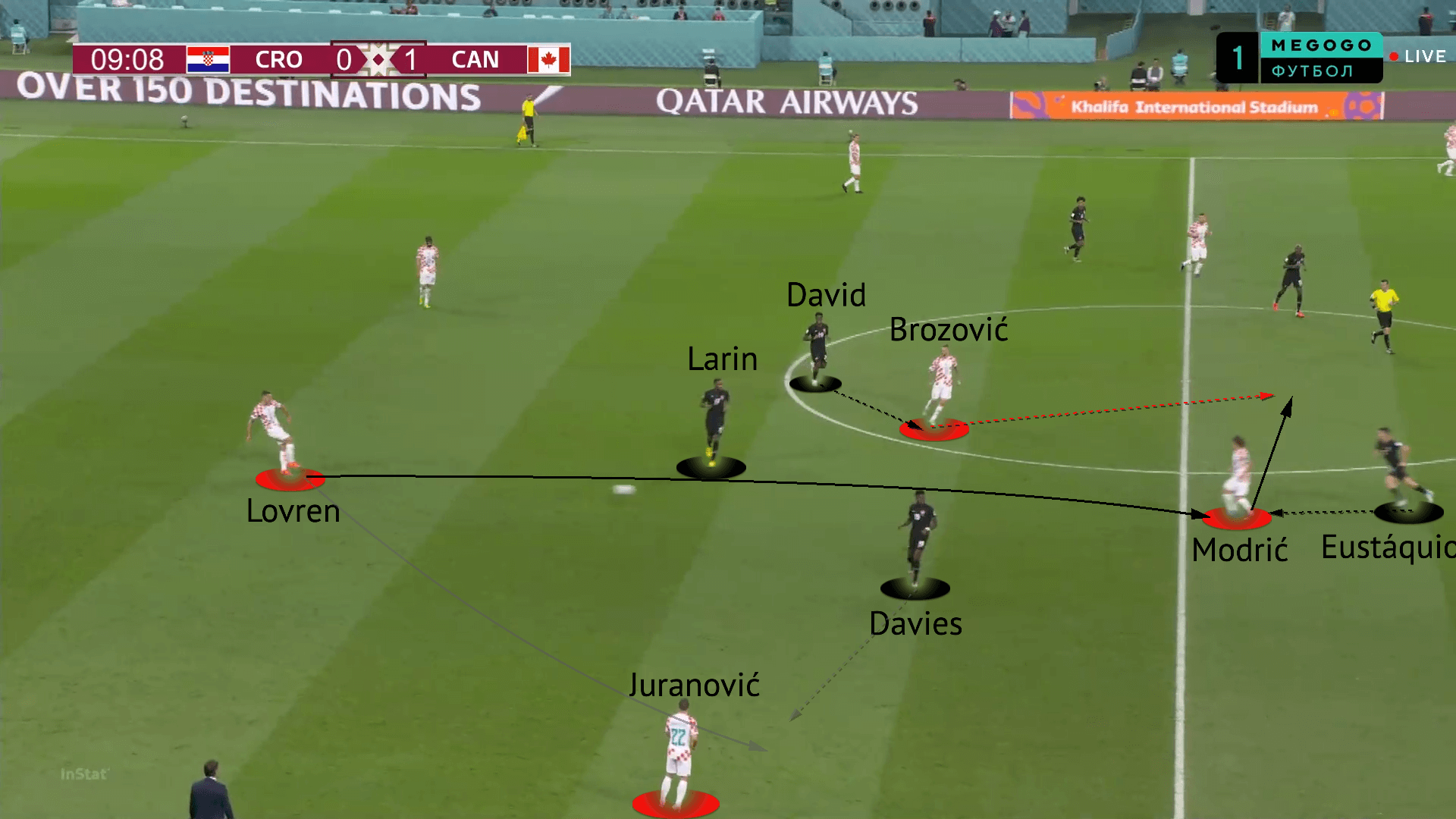
The figure above is another example of these factors. Larin goes to engage Lovren after the square pass from Gvardiol but doesn’t press with much intensity. Left midfielder Alphonso Davies is ready to jump the pass to Croatia right-back Josip Juranović whilst far-side striker David begins to drop onto Brozović. Without pressure, centre-back Lovren can fire the ball into Luka Modrić, who flexes his exceptional composure and technical capabilities to delicately lay off possession to Brozović and complete the up-back combination.
FC Porto’s Stephen Eustáquio was tasked with man-marking Modrić and had similar responsibilities against Belgium’s Axel Witsel. The Croatian was generally positioned higher up than against Morocco, where he often dropped between the centre-backs in an attempt to improve their rather lacklustre ball progression, which challenged Eustáquio’s awareness. Unfortunately, the Canadian midfielder suffered an injury and had to be substituted at half-time, but his first-half performance did impact Modrić’s initial influence.
The Real Madrid metronome made 88 offers to receive but only received possession from these 29 times, just 43.9%, which is comparatively less than against Morocco where Modrić also made 88 offers to receive but received possession from those 43 times. Typically, Croatia will trust Modrić’s brilliant receiving skills and access him even when under pressure, but Eustáquio’s commendable man-marking job was quite off-putting for Croatia.
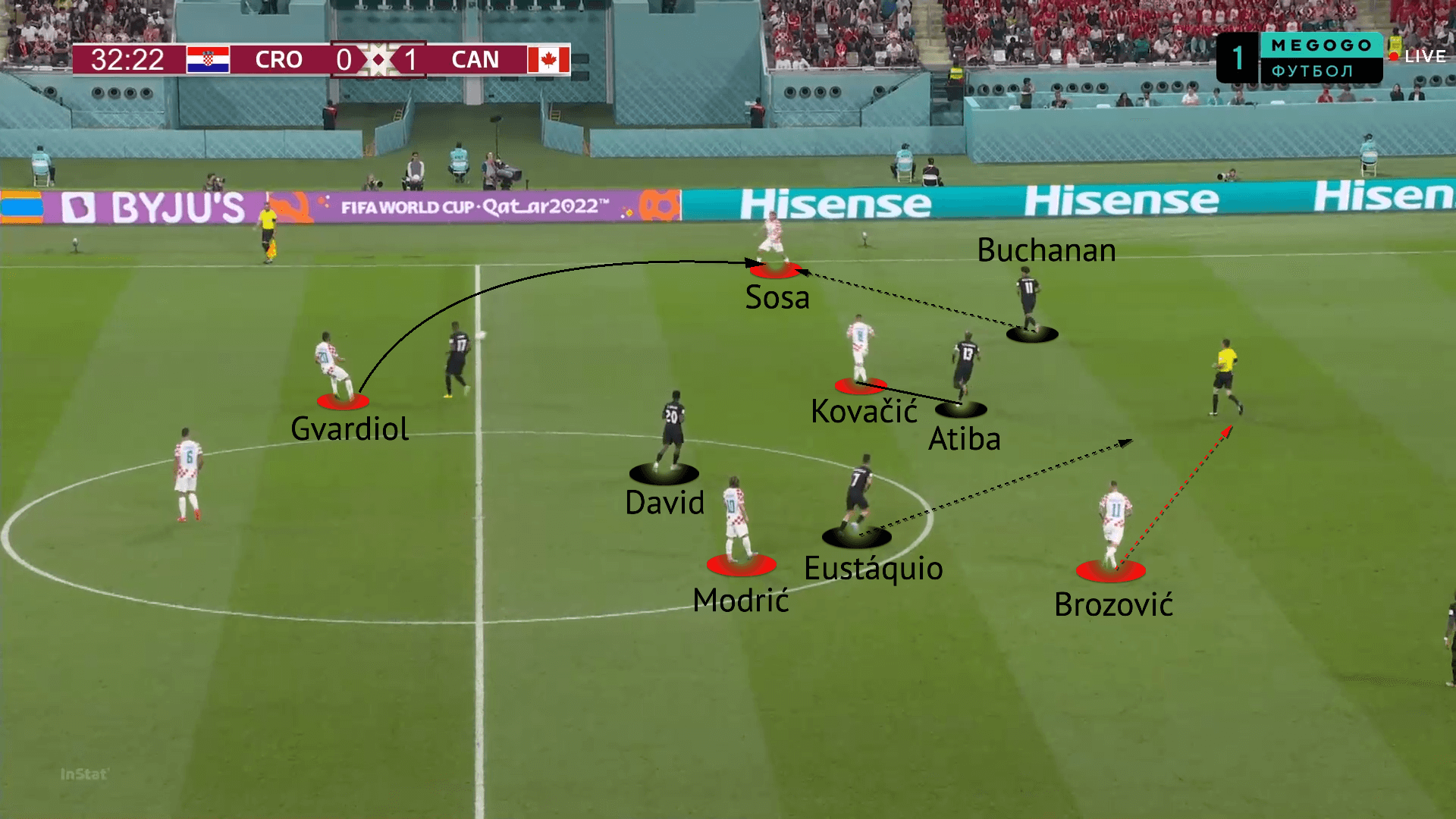
Although Canada coped with Belgium’s midfield overloaded in the opening stages in their first group game thanks to an all-around cohesive pressing display, the Maple Leafs couldn’t quite handle the Croatian midfield overload to the same effect. It soon became clear that the ageing Atiba Hutchinson was failing to influence, let alone dominate the midfield battle due to the extra man for Croatia.
The figure above once again shows Buchanan jumping the pass out to left-back Sosa with Hutchinson man-marking Kovačic as the ball-side central midfielder. Jonathan David was initially following Brozović whilst Eustáquio shadowed Modrić, until realising the rotation between the two mentioned Croatians. As Brozović makes a movement to receive ahead of the ball, Eustáquio quickly recovers to track the Inter Milan pivot. This passing on between David and Eustáquio was efficient for Canada, but couldn’t be relied upon against Croatia’s overriding quality.
Marko Livaja’s strike just before the break to enter the lead for Croatia further wounded Canada and John Herdman’s plans as they now had to come back from behind against a Croatia side that had numerical and qualitative superiority across the pitch to control the game. This prompted a double change and tactical switch from Herdman at half-time.
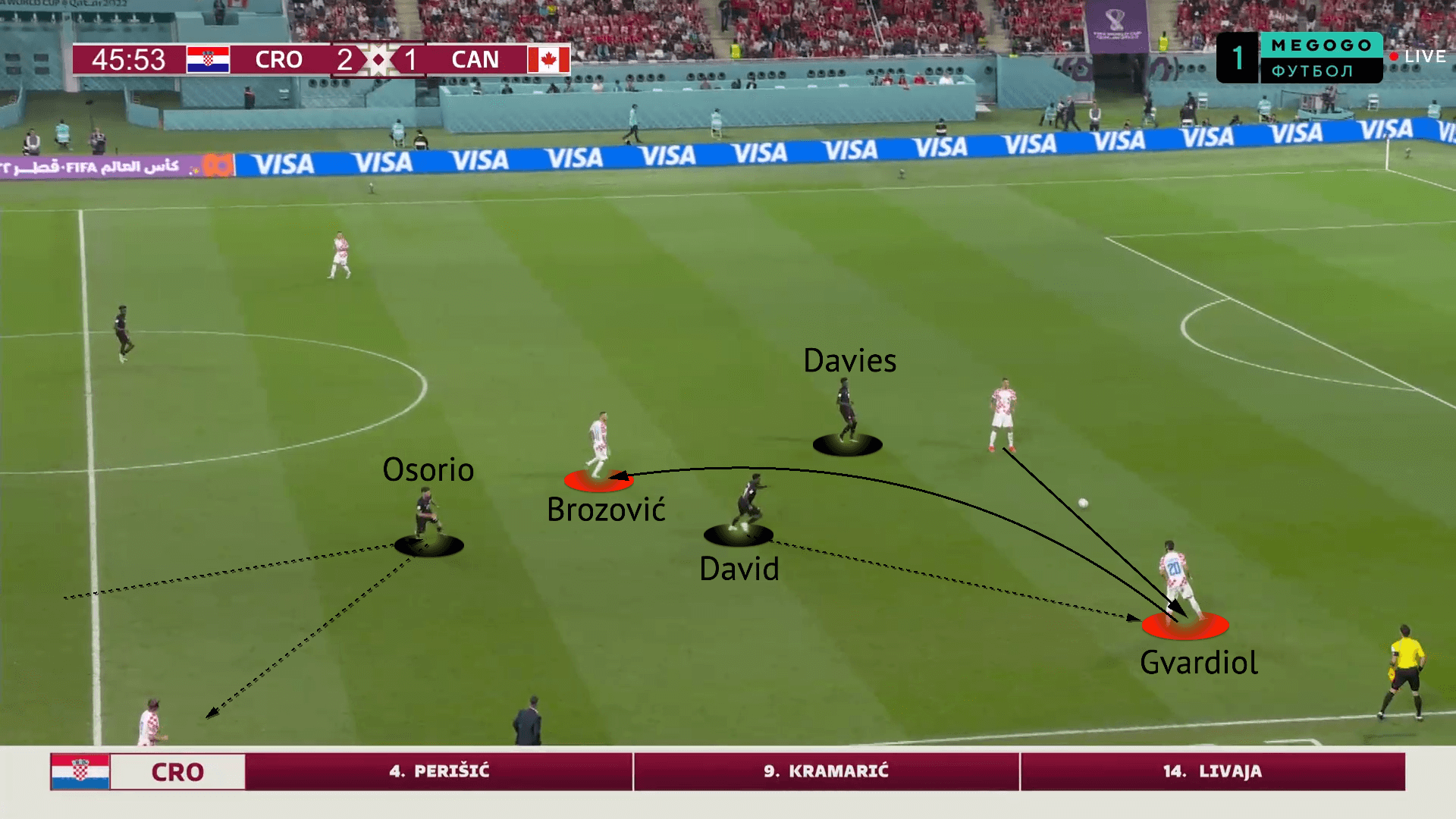
Canada changed their shape to a 5-3-2 with the arrivals of midfield pairing Jonathan Osorio and Ismaël Koné. As the injured Eustáquio and Larin departed, the substitutes joined Hutchinson in midfield whilst Alphonso Davies partnered Jonathan David upfront, forcing Buchanan to the right wing-back role. In theory, the 5-3-2 quashed the Croatian midfield overload and should’ve tightened up Canada defensively by equalling Croatia’s five men on the last line.
However, their pressing still lacked the intensity to seriously unsettle Croatia whilst the losing game state also affected the decision-making of Canada’s wing-backs to very attacking rather than providing an equilibrium.
Canada’s build-up
Against Roberto Martínez’s Belgium, Canada’s first phase of build-up and central midfielders’ work to receive was praiseworthy. Unfortunately, the Maple Leaf’s build-up was largely unsuccessful against Zlatko Dalić’s Croatia. Dalić’s approach was far from perfect high-pressing, with 30% of Canada’s in-possession play being unopposed build-up. Perhaps a telling sign of Canada’s struggles is the stark contrast between the two teams passing networks and most frequent player-to-player passes.
The 4-1 victors of Croatia displayed the ability to combine effectively with the attacking influences of Luka Modrić, Marcelo Brozović, Andrej Kramarić and Josip Juranović appearing alongside the centre-back pairing of Dejan Lovren and Joško Gvardiol in Croatia’s top five player-to-player passes. Canada, on the other hand, presents a failure to access attacking players.
Three of the top five most frequent player-to-player passing combinations involve the defensive line and Atiba Hutchinson making lateral or backward passes. Centre-back Kamal Miller finding Ismaël Koné was Canada’s third most frequent pass against Croatia. The inexperienced 20-year-old midfielder only played the second half but is clearly trusted by his teammates and manager John Herdman to perform on the biggest stage. CF Montréal’s Ivorian-born youngster exhibited his confident and impressive receiving skills against one of the World Cup’s most accomplished midfields and certainly has a bright future ahead.
Canada’s fifth most common pass was hybrid right-sided defender Alistair Johnston finding the talented Tajon Buchanan. Buchanan showed numerous quality touches and delivered a delightful whipped cross for Davies’ historic goal. 75% of Canada’s open-play xG was created from attacks in the right third with Buchanan threatening to pass.
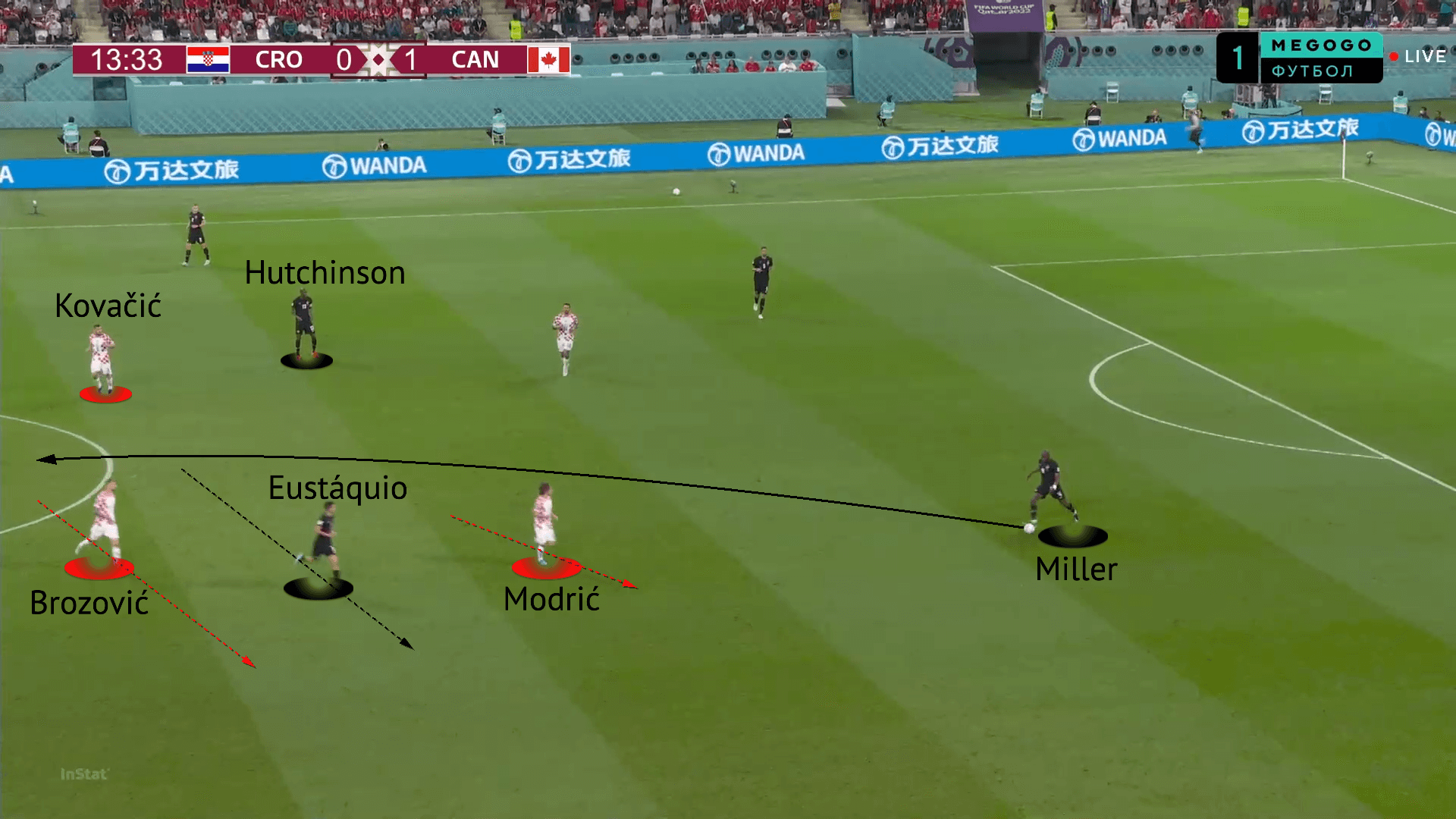
However, we did see the potential danger that Canada can create by looking to break lines centrally on a few occasions. In the example that can be seen in the figure above and below, Croatia are structured out of possession in a 4-4-1-1/4-4-2 with Modrić joining Marko Livaja in the front line.
Initially starting the sequence in the centre, Canadian central midfielder Stephen Eustáquio has moved away from the middle and attracted Brozović whilst also luring Modrić to change the angle of his run and keep Eustáquio in his cover shadow. The FC Porto midfielder is successful, increasing Miller’s time in possession and enlarging the vertical passing lane. LOSC Lille striker Jonathan David has effectively dropped off the Croatian defensive line to receive possession in space between the lines after Brozović was drawn out by Eustáquio. David looked to play wide towards Alphonso Davies and Richie Laryea but was unsuccessful.
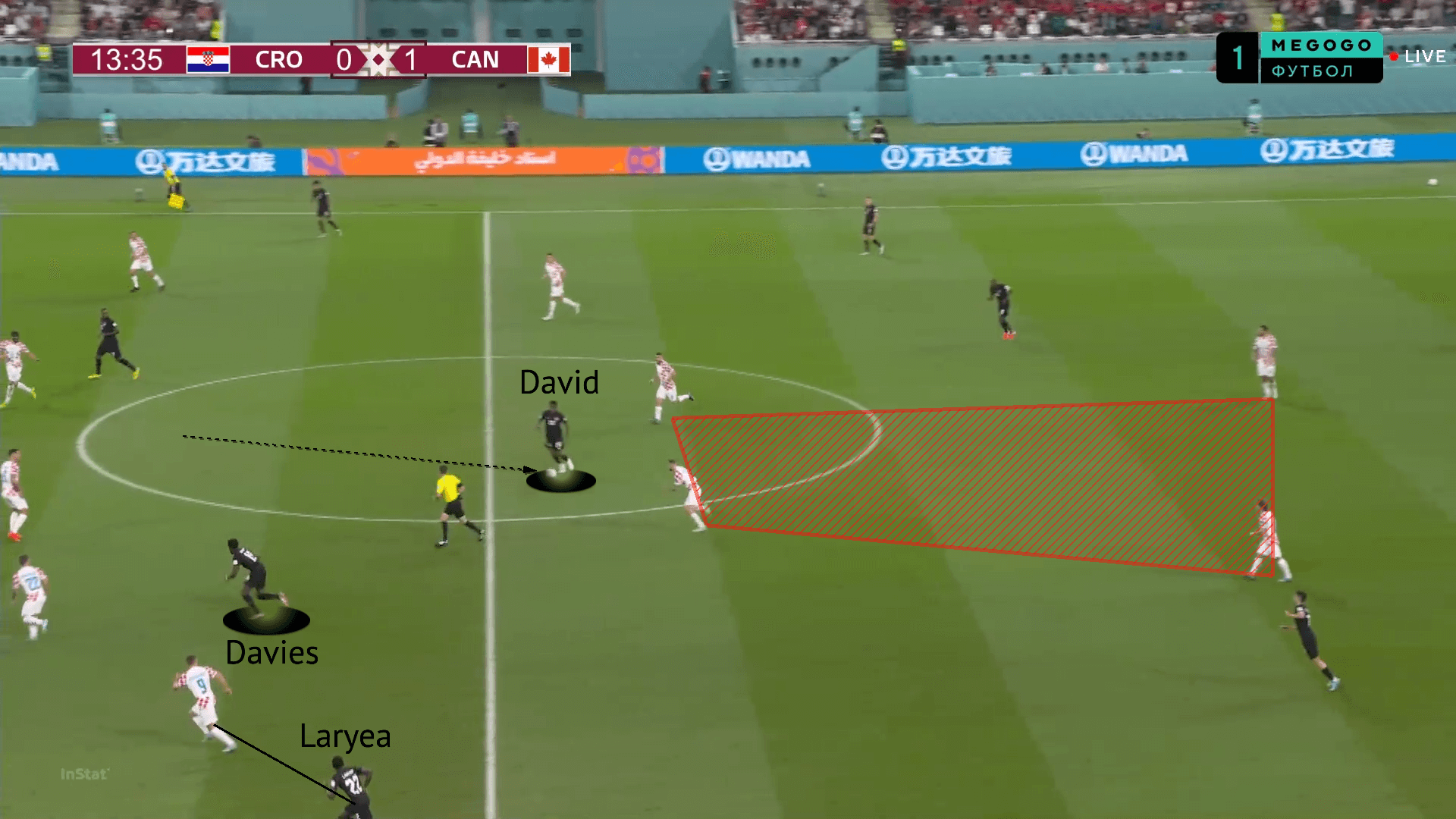
Kamal Miller’s ball-playing abilities are under-utilised by Canada, with the CF Montréal defender ranking in the 96% percentile for progressive passes per 90 against left centre-backs in the MLS. FC Porto’s Stephen Eustáquio can also play a prominent role in the build-up phase on the ball as well.
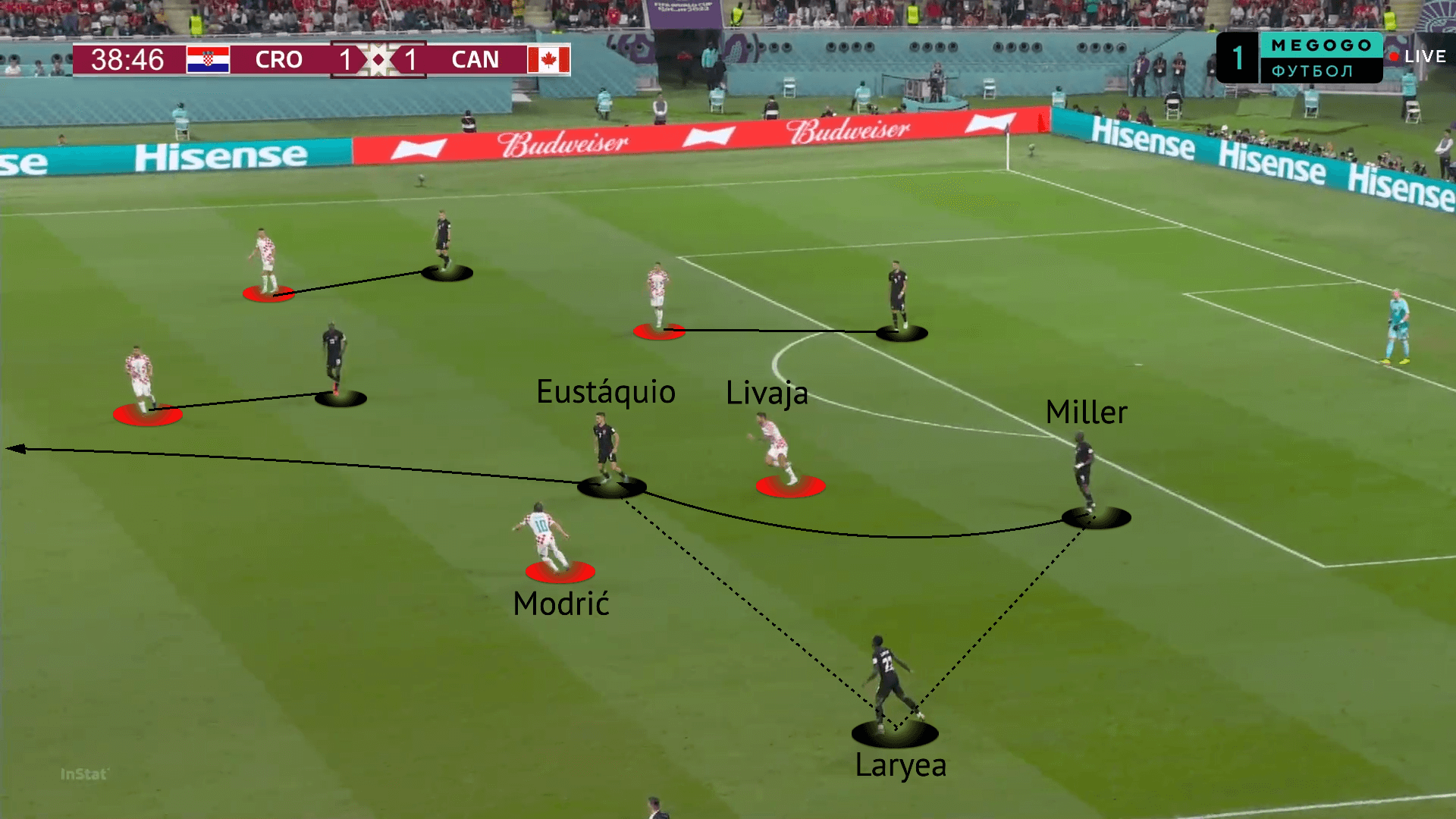
An example of this can be seen in the figures above and below. Canada have created an overload in the build-up with their 4-2 shape through the left side of Miller, Eustáquio, and Laryea. After drawing Livaja towards him, Miller can play the ball around the corner for Eustáquio to receive excellently on the half-turn. Facing forwards, the former Portugal under-21 international executes a wonderful pass behind Brozović for centre-forward David to drop off and receive once again. David takes a great first touch out of his feet but fails to find the run-in behind from Cyle Larin.
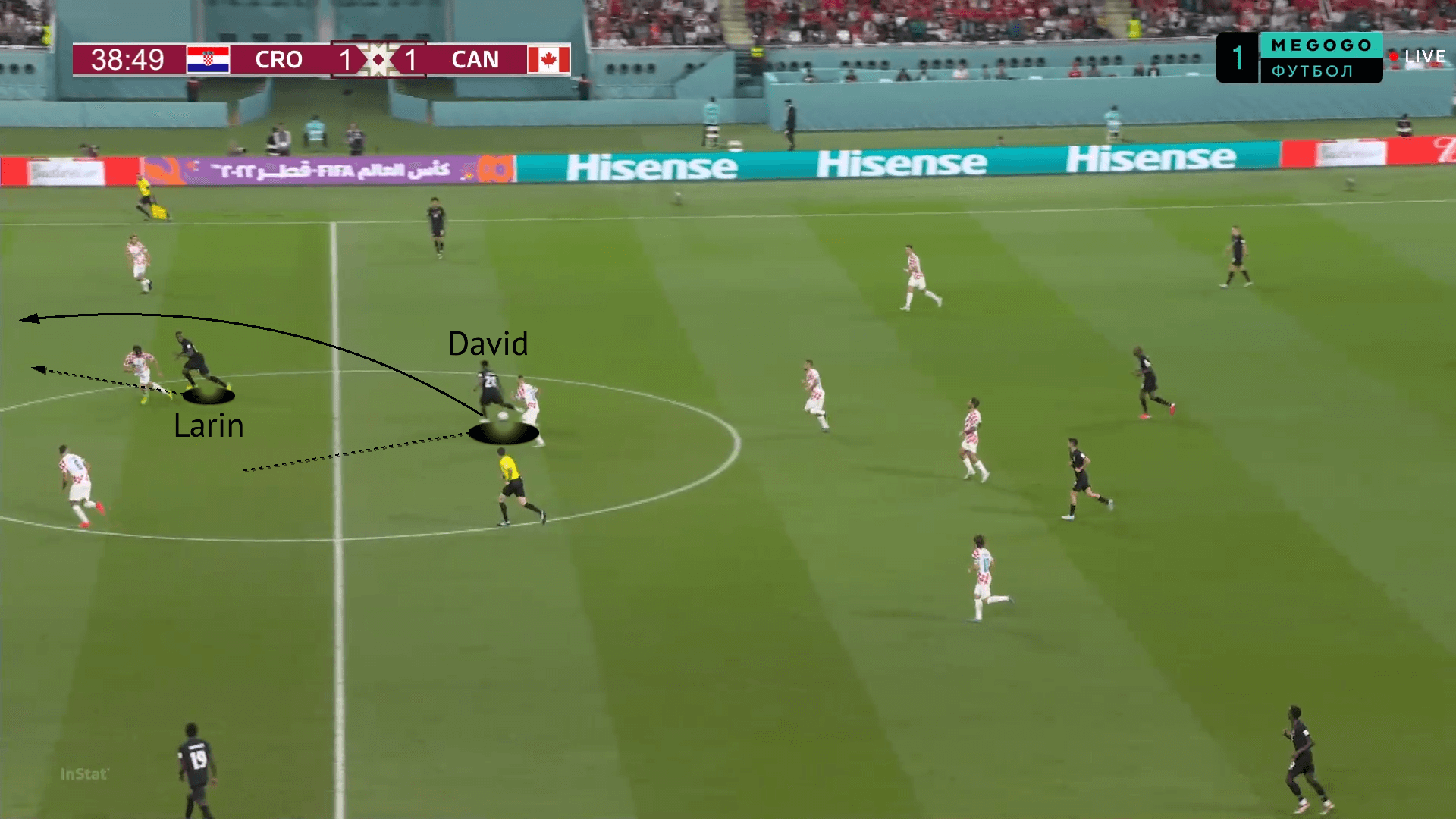
The striker dropping off the Croatian defensive line was an effective route of progression for Canada, although the end product was poor. The movement and creation of space between the lines helped disrupt the Croatian block and although David wasn’t performing to the usual all-around striker and playmaking proficiency, Canada should have attempted this more vertical approach more often.
Generally, Herdman’s side should’ve been more direct as an easier route of progression when Croatia looked to pin them deep. The Maple Leafs won twice as many aerial duels as Croatia, with the potential of gaining territory and retaining possession through long passes and second balls.
Conclusion
Despite the immense euphoria of scoring the first-ever goal in Canadian men’s World Cup history, the Maple Leafs ended the day devastated. Defeated 4-1 by the 2018 World Cup runners-up Croatia, Canada can feel unlucky to have faced two of Europe’s top teams, despite being significantly better than Belgium, to be knocked out of the tournament. John Herdman’s side provided excitement and drama, showing tactical flexibility and elite athleticism in attacking transitions and pressing.
They will be desperate to avoid returning home pointless, but really, they can be proud of their performances against some of the world’s best. There are promising signs for Canadian football, with this tournament laying the foundations for the Maple Leafs hosting the 2026 edition with USA and Mexico. The likes of Alphonso Davies, Jonathan David, and Tajon Buchanan will be bordering their peaks whilst youngsters like Ismaël Koné and Jahkeele Marshall-Rutty are potential starting options after furthering their development.
Croatia, meanwhile, still have a chance in this tournament. Their midfield trio of Marcelo Brozović, Luka Modrić and Mateo Kovačić have the quality and tournament experience to take their nation deep into the latter stages. Zlatko Dalić’s side also remained calm throughout this game and will continue to stay cool throughout the tournament, something that can’t be said about the intensely emotional and dramatic Argentina for example.
But Croatia must deal with Belgium to guarantee a space in the knockout stages of the 2022 FIFA World Cup before we can truly consider them as potential quarter-finalists, semi-finalists, or even finalists once again.

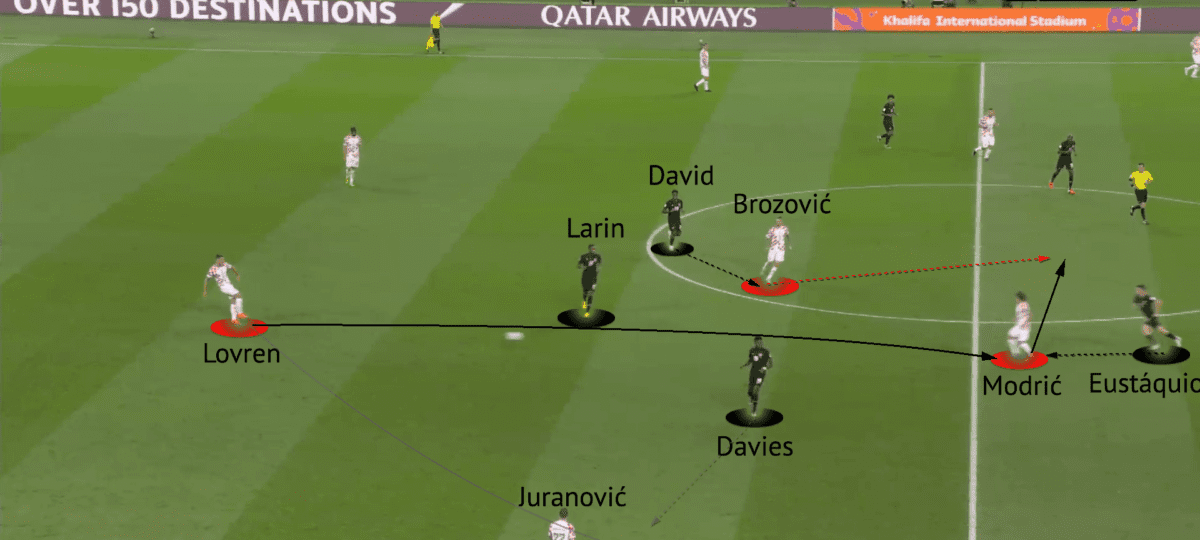




Comments